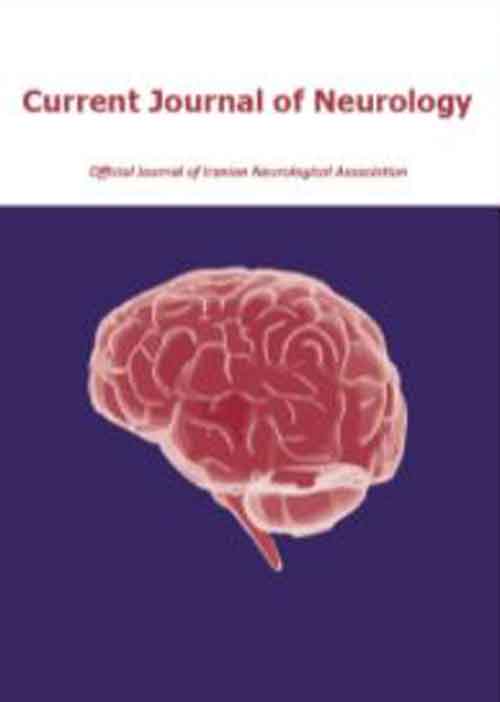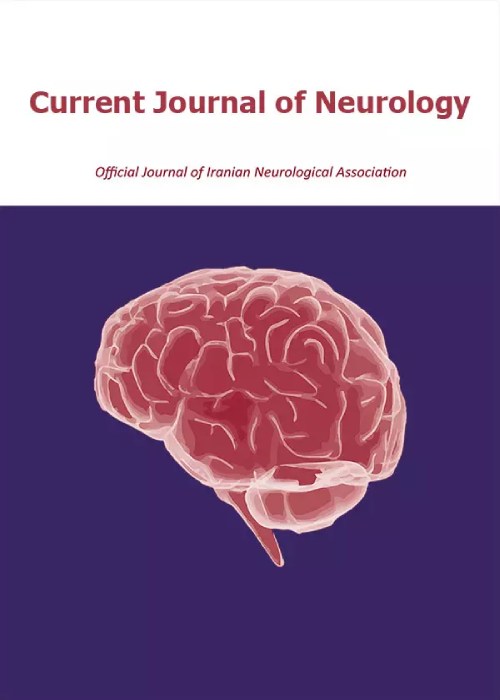فهرست مطالب

Current Journal of Neurology
Volume:20 Issue: 3, Summer 2021
- تاریخ انتشار: 1400/11/03
- تعداد عناوین: 10
-
-
Pages 120-124BackgroundMyasthenia gravis (MG) affects the neuromuscular transmission, causing fluctuating muscle weakness and fatigue. This study is carried out with the aim to study the electrophysiologic findings of different subtypes of MG referred to our center in Tehran, Iran.MethodsAll patients with MG presenting to neurology department of Shariati Hospital, Tehran University of Medical Sciences were enrolled. Clinically, patients with MG were categorized as ocular vs. generalized. The acetylcholine receptor (Ach-R) and muscle-specific receptor tyrosine kinase (anti-MuSK) antibodies were performed. Repetitive Nerve Stimulation (RNS) was performed using the standard method, with supramaximal stimulation of muscles at the 3 Hz frequency by surface electrode at rest. Abductor pollicis brevis (APB) (median nerve), anconeus (radial nerve), trapezius (accessory nerve), and nasalis (facial nerve) muscles were studied in all patients. Single fiber electromyography (SFEMG) was performed by standard method.Results196 seropositive patients with MG were included in the study. In electrophysiological studies, RNS was performed for 146 patients of Ach-R-Ab positive MG, with positive results in 110 patients. In addition, SFEMG was conducted for 8 patients with negative RNS, which resulted in 7 positive tests. Among 23 patients with anti-MuSK-positive MG, RNS was performed for 16 patients, with positive results in 11 patients. The 5 remaining patients with negative RNS test were studied by SFEMG, 4 of whom had positive results. APB compound muscle action potential (CMAP) decrementation significantly correlated with Ach-R-Ab positive MG (P < 0.03).ConclusionThis finding can support the hypothesis that the selection of muscles in electrodignostic study would be important. The electrodiagnostic studies are a good and non-invasive diagnostic tool for MG, and a combination of different distal, proximal, and facial muscles can increase the overall sensitivity of the test.Keywords: Electrophysiology, Myasthenia Gravis, Patients
-
Pages 125-130BackgroundAnticoagulation therapy following cerebral vein thrombosis (CVT) can improve mortality and morbidity. Vitamin K antagonists are currently the routine oral anticoagulant used for CVT; while by introduction of rivaroxaban, a direct factor Xa inhibitor, the attentions have been deviated toward novel agents, but the evidence is not strong. The current study is aimed to compare the efficacy and safety of rivaroxaban versus warfarin for anticoagulation therapy of CVT.MethodsThe current randomized clinical trial has been conducted on 50 patients with CVT among which, 25 ones were randomly allocated to rivaroxaban treatment (20 mg per day for three months) and remained 25 ones to warfarin treatment [adjusted based on international normalized ratio (INR) of 2-3]. The Modified Rankin Scale (mRS) and clinical investigations, including the incidence of seizure, papilledema, intra/extra-cranial bleeding, blurred vision, headache, nausea and vomiting, and death were evaluated at discharge time and within 3 and 6 months following CVT incidence; eventually, two groups were compared.ResultsComparison of mRS scores between the groups revealed significant differences in none of the interval assessments, at the time of admission (P = 0.510), within three months (P = 0.630), and within six months (P = 0.990), while both of the approaches led to significant decrease in mRS scores following both of the treatments (P < 0.001). The comparison of drug-related adverse effects showed insignificant difference between warfarin versus rivaroxaban (P > 0.050).ConclusionBased on this study, rivaroxaban is an efficacious agent for the treatment of CVT without remarkable adverse effects.Keywords: Cerebral Veins, Thrombosis, Warfarin, Rivaroxaban
-
Whole grains and legumes consumption in association with neuromyelitis optica spectrum disorder oddsPages 131-138BackgroundThe environmental risk factors of neuromyelitis optica spectrum disorder (NMOSD) are not fully specified.Regarding the evidence on the possible protective effects of whole grains and legumes against inflammatory disorders, we examined the association between the mentioned dietary components and NMOSD.Methods70 patients with NMOSD with definite diagnosis and 164 hospital-based controls were included in this case-control investigation. Data on demographic, clinical, and anthropometric characteristics were collected. Dietary habits of participants were assessed using a previously validated food frequency questionnaire (FFQ) containing 168 food items. Daily intakes of whole grains and legumes were calculated and classified in quartiles. The odds of suffering from NMOSD according to the quartiles of whole grains and legumes were measured in the form of logistic regression models.ResultsThe mean amount of whole grains (115.29 vs. 44.14 g) and legumes (59.43 vs. 34.50 g) consumption was significantly higher in the control group versus the case group. There was a reverse association between whole grains or legumes and NMOSD odds in both models [P < 0.05, odds ratio (OR) < 1]. In the fully-adjusted model, 90% [95% confidence interval (CI): 0.02-0.39] and 92% (95% CI: 0.01-0.52) reduction in NMOSD odds was observed in the third and fourth quartiles of whole grains intake, respectively. Higher intake of legumes in the third and fourth quartiles led to 81% (95% CI: 0.05-0.71) and 95% (95% CI: 0.01-0.27) reduction in the odds of NMOSD, respectively.ConclusionAligned with the results of other investigations on inflammatory disorders, our results suggested a negative association between whole grains and legumes and NMOSD odds.Keywords: Neuromyelitis Optica, Whole Grains, Fabaceae, Diet
-
Pages 139-145Background
Despite many studies, it is still unclear how patients with neuromyelitis optica spectrum disorder (NMOSD) would respond to coronavirus disease 2019 (COVID-19). We conducted a research on prevalence of COVID-19 in patients with NMOSD in Isfahan, Iran. We have also reviewed the recent publications on this issue.
Methods149 patients with NMOSD who were under medications were monitored for confirmed cases of COVID-19. Prevalence of COVID-19 in addition to mean age, mean duration of disease, and mean age of onset of infected patients and uninfected patients were calculated via Microsoft Excel software.
ResultsThe prevalence of COVID-19 in studied patients with NMOSD was 5.37%. Mean age, mean duration of disease, and mean age of onset of eight patients (male to female ratio: 1:3) diagnosed with COVID-19 were 33.62 ± 5.20 years, 6.87 ± 6.05 years, and 26.75 ± 6.94 years, respectively, while they were 39.97 ± 11.37 years, 7.50 ± 3.91 years, and 32.46 ± 11.29 years for uninfected patients with NMOSD (n = 141). No significant association was observed between the type of medications and prevalence of COVID-19 (P > 0.05).
ConclusionThere is not a consensus in the literature on the prevalence of COVID-19 in patients with NMOSD and the effect of NMOSD medications on susceptibility to severe acute respiratory syndrome coronavirus 2 (SARS-CoV-2). The prevalence of COVID-19 in our sample was 5.37%. The impact of the kind of NMOSD medication on the prevalence of COVID-19 in patients with NMOSD was found to be insignificant. Moreover, the infected patients were relatively younger, and their disease started earlier in comparison to uninfected patients.
Keywords: Neuromyelitis Optica, Autoimmune Disease, SARS-CoV-2, Covid-19 -
Pages 146-153Background
Cladribine tablets are the foremost oral immune-reconstitution therapy for high disease activity relapsing multiple sclerosis (HDA-RMS). We aimed to assess the cost-effectiveness of cladribine tablets compared to natalizumab in patients with HDA-RMS in Iran.
MethodsA 5-year cohort-based Markov model was developed with 11 expanded disability status score (EDSS) health states, including patients with HDA-RMS as on and off-treatment. All costs were identified from the literature and expert opinion and were measured in Iranian Rial rates, changed to the 2020 USD rate and were discounted by 7.2%. Quality adjusted life years (QALY), discounted by 3.5%, and life years gained (LYG) were adopted to measure efficacy. The final results were presented as incremental cost-effectiveness ratio that was compared to a national willingness to pay (WTP) threshold of 1 to 3 gross domestic product (GDP) per capita. Deterministic and probabilistic sensitivity analyses (D/PSA) were employed to evaluate uncertainty.
ResultsCladribine tablets dominated natalizumab and yielded 6,607 USD cost-saving and 0.003 additional QALYs per patient. LYG was comparable. The main cost component was drug acquisition cost in both arms. DSA indicated the sensitivity of the results to the cost discount rates and also the patients’ body weight; while they were less sensitive to the main clinical variables. PSA indicated that cladribine tablets were cost-effective in Iran, with a probability of 57.5% and 58.6% at lower and higher limits of threshold, respectively.
ConclusionCladribine tablets yielded higher QALYs and lower costs compared to natalizumab, in patients with HDA-RMS in Iran.
Keywords: Cladribine Tablets, Natalizumab, Relapsing Multiple Sclerosis, Cost-Utility Analysis, Pharmacoeconomics Study, Iran -
Pages 154-161BackgroundThe current study desired to conduct an economic analysis on ocrelizumab (OCR), a new relapsing multiple sclerosis (RMS) treatment strategy, in comparison to natalizumab (NTL), as one of the mostly-used disease-modifying therapies (DMTs) in Iran.MethodsA 31-health-state Markov model, based on Expanded Disability Status Scale (EDSS), containing patients on- and off-treatment with annual cycles was developed. Baseline demographics and utility scores were extracted from OPERA 1 and 2 trials. Confirmed disability progression (CDP) and annualized relapse rates (ARR) were extracted from the literature. Mortality was calculated based on age, sex, and disease state. Quality-adjusted life years (QALYs) and life years gained (LYG) were measurements of efficacy. Direct and indirect costs were identified and calculated based on the national book of tariffs in Iranian Rial (IRR) rates, then converted to the 2020 United States Dollar (USD). Final results were reported in terms of incremental cost-effectiveness ratio (ICER), which showed extra costs required for one additional QALY. Robustness of the model was analyzed through deterministic sensitivity analysis (DSA) and probabilistic sensitivity analysis (PSA).ResultsOCR dominated NTL and was associated with cost-savings of 6971 USD, longer LYG (0.004), and higher QALYs (0.27). Although OCR had higher acquisition costs, which was the main component in both comparator arms, it was associated with lower total costs, due to lower disability progression and productivity loss. Results remained robust in DSA and PSA (93.5% cost-effectiveness in Iran’s pharmacoeconomic threshold, 2709 USD).ConclusionResults suggested that OCR was a more cost-effective option than NTL for the treatment of patients with RMS in Iran.Keywords: Multiple Sclerosis, Immunologic Factors, Monoclonal Antibodies, Cost-Effectiveness Analysis, Iran
-
Pages 162-165BackgroundCoronavirus disease 2019 (COVID-19) is spreading rapidly and has affected millions of people worldwide. Comorbid diseases have complicated the course of infection and increased mortality. Myasthenia gravis (MG) affects the neuromuscular junctions (NMJs) and can compromise respiratory muscle action, leading to worse clinical outcomes in individuals infected with the COVID-19 theoretically. In this study, the aim is to assess the pattern of COVID-19 infection in patients with MG based on several factors.MethodsThis was a prospective cohort study following 150 patients with MG over a six-month period. The patients were monitored for the development of signs and symptoms of the COVID-19 infection.ResultsComparison of the patients infected with COVID-19 with MG and those not infected was performed independently based on age, duration since MG diagnosis, status of thymectomy, and current clinical status of MG disease. Data analysis did not reveal increased susceptibility or increased severity of COVID-19 illness based the criteria assessed.ConclusionCOVID-19 related deaths and susceptibility were not related to age, thymectomy status, and disease duration in patients with MG.Keywords: Myasthenia Gravis, Covid-19, Thymectomy, Neurology
-
Pages 166-184Background
The environmental factors play a role as risk factors of multiple sclerosis (MS). This study aimed at gathering environmental risk factors of MS in the Middle East and North Africa (MENA).
MethodsWe used MEDLINE and EMBASE databases by a systematic review method. Out of a total of 123 studies, 16 studies met the eligibility criteria.
ResultsTotally, 47 risk factors were assessed as follows: six studies found sunlight exposure as a protective factor with the odds ratio (OR) ranging from 0.06 to 0.57. Six studies evaluated smoking as a risk factor with the OR ranging from 1.69 in all patients to 6.48 in female patients. Four studies supported measles infection as a risk factor with the OR ranging from 1.60 to 3.77, and in 3 studies, stressful events had a significant association with the OR of 1.80, 1.90, and 32.57.
ConclusionAmong 47 assessed risk factors, sunlight exposure, cigarette smoking, measles infection, Epstein-Barr virus (EBV) infection, and stressful events had a significant association with MS.
Keywords: Multiple Sclerosis, Risk Factors, Environment, Middle East, North Africa


